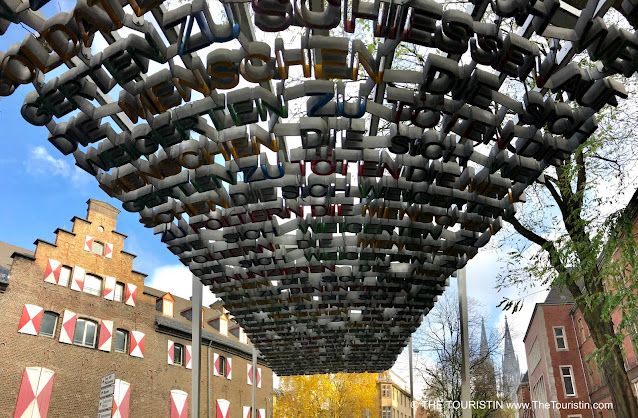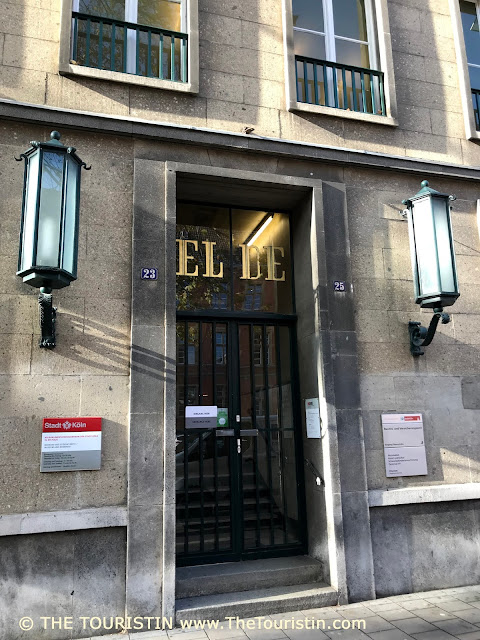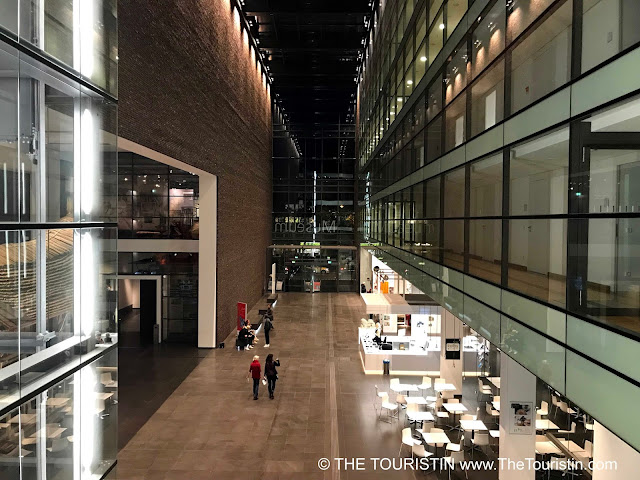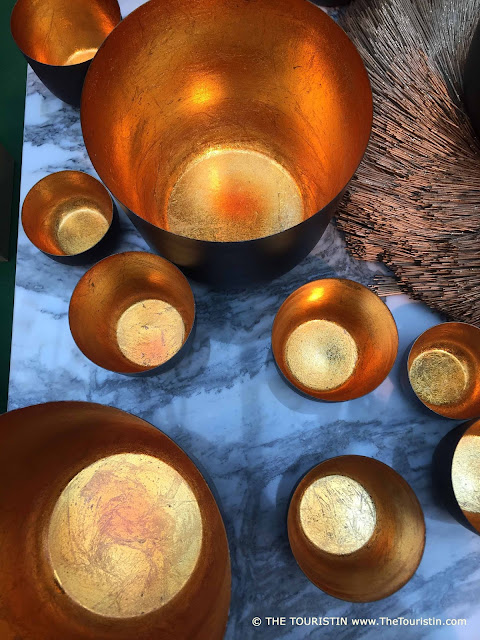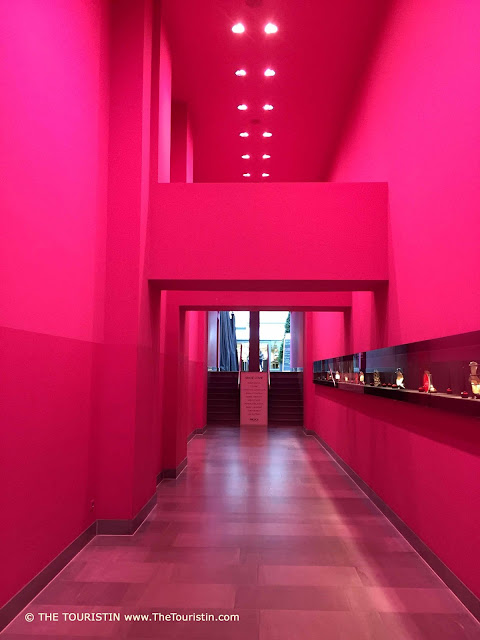Where is Cologne? You find the town in the state of North Rhine-Westphalia, 580 kilometres to the west from the capital Berlin and 260 kilometres to the south-east from Amsterdam in The Netherlands. If you visit Cologne you can expect to walk through a 2,000-year long history and that together with 1,000,000 locals. Cologne, is a town with a big heart, and is called affectionately Koelle by locals. An area of 800 hectares of green, half of which is wooded runs around Cologne like a green belt. The motto of the city is open-minded, tolerant and multicultural.
Cologne is divided into nine different boroughs and each of these has several smaller districts, in fact, there are 86 different ones. This guide focuses mainly on the central districts, this is where I know my way around, and it is curated with love.
Cologne Cathedral – The Famous Star
The handsome Gothic Cologne Cathedral (der Dom in German), whose foundation was laid in 1248, is the town's landmark and a UNESCO World Cultural Heritage site. The third highest cathedral in the world is 144.58 metres long and stands 157.31 metres tall (north tower, the south tower is 7 centimetres smaller). It weighs 160,000 tons, which is the weight of 2,500 jumbo jets. The cathedral has magical powers. In case one has too many drinks and intercourse (with the wrong person) during carnival, fearing purgatory, seeking forgiveness... Legend has it that one needs to simply walk in a circle around the cathedral and all sins are forgiven. There even is a hashtag on Instagram that shows how locals love their town and the cathedral: #homeiswherethedomis.
Info: Cologne Cathedral. Hours: November to April 6am to 7.30am. May to October 6am to 9pm. Sundays and public holidays: 1pm to 4.30pm. Tickets: Free.
Farina Fragrance Museum – The world’s Oldest Perfumer
One of the first things that come to mind when thinking of Cologne is the scent 4711. Think again. At the beginning of the 18th century, only a few people had a loo, garbage was thrown on the streets and people were sort of suspicious of personal hygiene. Johann Maria Farina, at that time perfumer in Cologne, dreamed of a better smell for his hometown. He travelled the world, always looking for innovative fragrance creations. In the distillation of bergamot, lime, grapefruit and orange, a smell that reminds him of an Italian spring morning, just after it rained (he was born in Italy), he finds the one. In 1709 Farina Original Eau de Cologne was born. Since the Rococo period, a time of glamorous feasts of nobles and the rich and beautiful, the whole world is crazy about the fragrance. To this day, more than 300 years later, the company is still owned by the same family.
What is the story of 4711? As a copy of Johann Maria Farina’s Original Eau de Cologne Wilhelm Mülhens also created a scent and called it after the house number his store was at. 4711 was born and is today the famous one. The founder sold it to American multi-national goods corporation Proctor and Gamble and they sold it to Maeurer and Wirtz.
Visit the Farina Fragrance Museum museum and check out the whole story, there is also a gift store where you can buy the delicious scent.
Details: Farina Fragrance Museum. Farina-Haus, Obenmarspforten 21, 50667 Cologne. Hours: Monday to Saturday 10am to 7pm. Sunday 11am to 5pm. Tickets: The fragrance museum can only be visited within a 45 minutes long guided tour. Buy tickets online and choose a time that suits your schedule. Tickets EUR 5 to EUR 9 per person.
El-De House - Cologne under National Socialism
The EL-DE-Haus, named after the initials of the master-builder and goldware and watch wholesaler Leopold Dahmen (LD, spoken El De), was the seat of the Cologne Gestapo from 1935 to 1945. That name became the epitome of Nazi reign of terror in Cologne, but also for dealing with and reflecting on the Nazi history of the city after 1945. While everything else was almost all in rubble this property wasn't destroyed in WW2. Soon after the war the Germans just used this building where people had been tortured and more than 400 people murdered during the war, for state-run offices, and there even was a registry office. In the heart of the city, the house is in an excellent location, all atrocities happened right in front of the locals.
The NS Documentation Centre of the city of Cologne is the largest local memorial site for the victims of National Socialism in Germany. The Gestapo prison with its collection of inscriptions and drawings of prison victims is a cultural monument of national and European importance. On the premises, The Information and Education Centre Against Right-Wing Extremism offers advice and support for residents in the prevention against right-wing extremism and racism. The Nazi Documentation Centre supported the project Stolpersteine from the start and promotes its realization.
A few metres from here you find the installation by Swiss designer Ruedi Baur which honours deserters and war opponents from the time of National Socialism. Appellhofplatz, corner Burgmauer / Neven-Du-Mont-Straße.
Info: El-De Haus, Appellhofplatz 23-25, 50667 Cologne. Tuesday to Friday 10am to 6pm, Saturdays and Sundays 11am to 6pm, 1st Thursday of the month (except public holidays) 10am to 10pm. More museums about National Socialism in Germany, please read these articles about Munich and Berlin.
Museum Ludwig
The Ludwig Museum is all about modern and contemporary art. It is known for the world's largest Picasso collection, the largest collection of Pop Art outside the US and the Russian avant-garde.
It houses the largest collection of Pop Art outside the United States ever since collectors Peter and Irene Ludwig donated their collection, including works by Roy Lichtenstein, Andy Warhol, Claes Oldenburg, Robert Rauschenberg and Jasper Johns to the city of Cologne in 1976.
You will also have the chance to look at works from Gerhard Richter, Joseph Beuys, Jörg Immendorff.
The Haubrich Collection features Classical Modernism and Expressionism with works by Otto Dix, Emil Nolde, Marc Chagall, Max Beckmann and many more artists of the time. The graphics collection holds around 3,000 drawings and nearly 10,000 graphic works. Add on: great view towards the Cathedral.
Info: Museum Ludwig, Heinrich Boell Platz. 50667 Cologne.Tickets: Adults: EUR 11. Families EUR 22. Groups EUR 8 per person. For adolescents under the age of 18 the permanent exhibition is free. For children under the age of six the entrance to the permanent exhibition and special exhibitions are free. Hours: Tuesday to Sunday (including bank holidays): 10am to 6pm. First Thursday of the month: cabarets, concerts, talks, tours, 10am till 10pm. The museum is wheelchair accessible.
Love Locks on Hohenzollern Bridge
Love locks are one of Cologne’s cutest traditions. As proof of your love, lock a small padlock to the handrail of Hohenzollern Bridge. To make sure your love lasts forever and ever, throw the key into the River Rhein.
BRITNEY
The Schauspiel Koeln offers concerts, readings, performances and films.
Info: Schauspiel Koeln, Britney, Offenbachplatz. 51063 Cologne. Check the program and get tickets here. The entrance in some areas is accessible to wheelchair users.
Three Walking Adventures in Cologne
Stroll along the marina, called Cologne Rheinauhafen, and marvel at the stunning architecture. If we look back only 100 years, goods were still being loaded onto the cargo ships; today this area is Cologne's trendiest urban development project. The old warehouses are now home to offices. Look out for the Siebengebirge, the former granary. Walk towards the very end of the marina where the old refurbished harbour office is.
Make your way to the Pollerwiesen, on the right side of the River Rhine between the South and the Rodenkirchen bridge. On warm days this is the place to be for all sun lovers and outdoor fans.
From the Aachener Weiher, a small artificial lake that is hugely popular with locals, you can spend hours walking under chestnut trees along the Clarenbach- and the Rautenstrauch canal all the way to the city forest. If you are here in summer: Make your way back to the Aachener Weiher in the late afternoon, this is such a fun place, grab a Gaffel Koelsch (beer from Cologne), find a seat on the lawn and enjoy the night.
Fish Market in the Old Town
In the 12th century this square, called Fish Market, was first mentioned. Trading in fish was big business in medieval times. Locals strictly obeyed the rule of fasting on Fridays, and to only eat fish. In the Catholic tradition, every Friday is a memorial day of the death of Jesus. In the memory of that day, believers have to fast on Fridays. For Catholics that means to eat no meat. Clever as they are, they tweaked that rule and declared that fish is not "proper" meat. It came in handy that fish was also affordable for the poor. At the time locals were allowed to buy the fish, and also to preserve it to export it. It was not a given that the fish was sold by women. In some cities, women weren't allowed to trade in fish whereas in Cologne they were at least given permission to sell the smaller varieties. Larger specimens, which had to be weighed, were only sold by men. When, at the end of the 15th-century, women were prohibited to trade in salted goods the only fish they could trade in were herrings. There is this fountain in memory of the trading fish women. Can you imagine somebody would tell you what you can and what you can't do? It shows everything is possible.
Rautenstrauch-Joest-Museum – Travels Around the World
You don't have to travel far to have a good time; you can go on a world tour right here in the very centre of Cologne. The Ethnological Collection is a trendy museum with a great character. On multimedia and interactive explorations, visitors get a wonderful insight into the lives of different cultures. The dream of most tourists, to see how locals live, comes true in this place.
The collector Wilhelm Joest was a true explorer; one gets a view into his life and his travels around the world. He was heavily interested in discovery but at the same time believed in colonialism and with that held the view to be superior to other ethnicities. It is disturbing imagining someone believed in that, but shows that humanity came a long way, to be where we are today. After the explorer died his sister Adele Rautenstrauch was the heir of his collection and fortune, and founded the Rautenstrauch-Joest-Museum. She created something wonderful. When you look at 65,000 objects from Oceania, Africa, Asia and America, it quickly becomes obvious that there are countless different rituals and traditions, but that, in the end, all humans are the same.
Info: Rautenstrauch-Joest-Museum, Caecilienstrasse 29-33, 50667 Cologne. Hours: Tuesday, Wednesday, Friday, Saturday, Sunday 10am to 6pm. Thursday 10am to 8pm (1st Thursday of the month 10am to 10pm). Monday Closed. The museum is wheelchair accessible. Tickets: Tickets. Single ticket permanent exhibition: EUR 7, concessions: EUR 4.50. Group ticket permanent exhibition from 10 persons: EUR 4.50. Special exhibitions EUR 4, concessions: EUR 3. Group ticket special exhibition over 15 people: EUR 3 per person.
Ehrenstrasse
There simply is no way around it. Many moons ago, the Ehrenstrasse was the place to go to for all those who were looking for individual and high-quality fashion. The street certainly still holds that flair, but today you also find COS, H&M, ZARA, & Other Stories and the like. You can also visit one of the most amazing cheese shops ever (Kaesehaus Wingenfeld, Ehrenstrasse 90) which opened its doors in 1896 and offers about 350 varieties of cheese.
Mittelstrasse
Boutiques, art dealers, galleries. It is all here on one street. And sort of just around the corner from Ehrenstrasse. Walk through the pink gallery to check out Apropos (Mittelstrasse 12), a concept store that sells men’s and women’s wear.
Belgian Quarter – Short Guide to a Few Favourites
There are no big chains on Maastrichter Strasse, Bruesseler Strasse, Bruesseler Platz, Antwerpener Strasse, Limburger Strasse… and there never were, and there hopefully never will be. Please.
Siebter Himmel. Books, cooking supplies, art, children's toys, fashion - one feels like being on cloud nine. In case you wonder the reason this store is called Siebter Himmel (Seventh Heaven), the Germans say they are in the sevenths sky when they are on cloud nine. The street art on the façade is by Boris Hoppek, who uses his work to address political issues such as immigration, racism and violence. Info: Siebter Himmel, Bruesseler Strasse 67, 50672 Cologne. Hours: Monday to Saturday 10am to 7pm.
Bruesseler Platz. There is this neo-Romanesque church called St. Michael on Bruesseler Platz, and on weekends the crowds gather here for drinks. You know it is legal to drink alcohol in public in Germany, no, no wrapping paper needed to cover your bottles either.
Hallmackenreuther. This is a café bar for every time of the day. Highlights are the mid-century decor and the view of St. Michael. Info: Hallmackenreuther, Bruesseler Platz 9, 50674 Cologne. Sunday, Monday, Tuesday, Wednesday, Thursday 10am to 1am. Friday and Saturday 10am to 3am. (Update: Permanently closed, it might re-open again?)
Sorgenfrei – Eat without a care in the world. This is the perfect name for this restaurant. Relaxed atmosphere, a warm welcome and great food paired with European wines. Try the baked chickpeas with yoghurt, grapes and estragon. Info: Sorgenfrei, Antwerpener Strasse 15, 50672 Cologne. Hours: Monday to Friday 12pm to 3pm and 6pm to 12am. Saturday 6pm to 12am. Sunday Closed.
Schee. Looking for a fun and stylish limited and signed print to hang on a wall? You will definitely find it here, together with beautiful stationery products, glassware and textiles. Info: Schee, Maastrichter Str. 36, 50672 Cologne. Hours; Monday to Friday 11am to 8pm. Saturday 10am to 8pm Closed Sundays.
Metzgerei Schmitz. This café, next door to Salon Schmitz is a must-visit in the Belgian Quarter. Perfect for breakfast and to people-watch. Never a dull moment. Info: Metzgerei Schmitz, Aachener Strasse 30, 50672 Cologne. Hours: Monday to Thursday 9am to 11pm. Friday and Saturday 9am to 1am. Sunday 9am to 10pm.
When is the best time to visit Cologne?
It is best during Karneval to party for six days in a row, dance, to fancy dress, to drink and sing loudly. Due to its location on the River Rhine and the adjacent low mountain heights, the climate is relatively mild. Even in the dead of winter, you won't have to fear the chance of proper snow. Spring and summer are pleasant; bring an umbrella in any case.
How to get to Cologne?
By car from Berlin approx. 540 kilometres.
By car from Elba in Italy approx. 1270 kilometres.
By plane. Visit the website of the airport to check flight connections.
By train. Visit the website of the Deutsche Bahn for tickets and connections.
From Berlin with love


